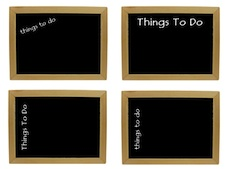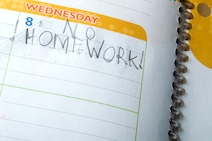TweenTeacher’s Four Middle School Startup Tips
I love summer. However, it isn’t because I rest or relax per se. It’s because I can plan, prep, reflect and devise, without the musical din of tweens going on around me.
In summer, I replace the adolescent chatter with the din in my own head — wondering what devious Project Based Learning unit my next group of unsuspecting tweens will fall victim to. Bwa-ha-ha-ha!
Now I have time to create plans to stretch them, pull them and guide them towards new skills and new strategies to help them get through ELA — a class I think of not so much as a place to learn to read and write about literature, but one in which they’ll learn to communicate any content, be it science, history, math, music, or computers.
Sometimes the night before school starts I have nightmares, just as we all do. But as I get deeper into practicing Project Based Learning, I find that my sleeplessness has less to do with fear and more to do with excitement. These days, I find myself losing sleep thinking about what my Honors classes will say when I show them the iMovie introducing our new Superhero/United Nations Advocacy unit.
I lose sleep in anticipation of introducing my remedial classes to their own classroom iPads, all set up with differentiated apps and a virtual classroom of their own to explore long after the last school bell rings. I lose sleep because I’m too excited! about meeting my newest Speech and Debate team and introducing them to the process of digitizing our speeches into a Google Drive portfolio.
But then I have to stop myself
Before I get to do the fun stuff — before I get to launch them into different directions and before they can trust me that my classroom is a safe place to laugh loudly, ask stupid questions, critique each other, imagine together, and learn from one another regardless of whether they sit together at the same lunch table — I have to introduce them to the tone and structure of the classroom.
Classroom management is vital in the first few days and weeks, as we all know, and with rules established right off the bat, their flight into upper atmospheric learning can launch far more smoothly and efficiently.
Four things I do the first days of school

1. Setting up my initial seating chart. This I do randomly on the first day of school. I get two decks of playing cards. From one, I tape random cards to each desktop. Then I take the corresponding cards from the second deck and pass them out at the door. As each student trickles in, they spend a couple of minutes finding their seat. It randomizes everything and gives them something to do while others find the classroom on that first day.
At every student’s chair, I’ve already placed a student data sheet, a basic fill-in-your-info page that helps me immediately learn a little about him or her. It asks for contact info, schedule info, etc…and the final question asks if there’s anything about their seating they think I need to know. I get responses like:
“I’m deaf in my right ear.”
“I can’t see from the back.”
“I can’t stand Justin! Please don’t sit me with him!” (This is a request I might give into at the start of the year, but within a few weeks, all bets are off.)
Within the first 3 days, from looking at the student data sheets, and the level of success (or not) of the randomization process, I can to firm up my start-of-the-year seating chart. This chart is fluid and constantly changes. Which brings me to…
2. Practicing fluid grouping to prepare for immediate collaborative activities. Before the kids ever enter my room, I have labeled the desks with characters from books in my classroom library. In other words, I use “content area” names to identify each seat at each table. Any subject can use this method using their own terms or names.
So at table 1, there are 4 seats: Mr. Darcy, Skullduggery, Katniss, and Hermia. At table 2 are the same characters. By labeling the table groups, I can say things like:
“All Hermias, please go get your Works in Progress folders.”
“Mr. Darcys, please all gather over in the classroom library to do an author’s share.”
“During silent reading, I’d like to see all of the Skullduggery folks over at my desk to talk about your rough drafts.”
In addition, every week or so, the kids will rotate positions so I don’t have to see the backs of the same kids all quarter. This also supports Judy Willis’ theories of student achievement and how it relates to new perspectives of the classroom environment.

4. The Classroom Constitution. Our first few days are spent developing our online and offline norms in the classroom. Establishing these rules of behavior, academically and otherwise, is critical during these first days. I take it one step further and have the students create quills, dip them in ink, and actually sign the constitution that hangs in the classroom. Once I post the constitution online, they also have to type their first names into the comment field of the post as a “signature” to show that these rules apply anywhere they are interacting. By helping to formulate the rules of the classroom, they more fully own them.
Good luck in your own first few days. And if you’ve already started school, I hope you’ll still find some ideas here that might be helpful.
If you’re a first year teacher, just getting underway, I hope you are losing sleep — not out of fear but out of excitement. And don’t worry if you wake up groggy after only a couple hours sleep; the din from a new cohort of middle schoolers is better than any caffeinated beverage.
May you have a great school year guiding a new group of tweens — and may you also have a great year learning from them!
Heather Wolpert-Gawron is an award-winning middle school teacher who blogs at Tweenteacher and at Edutopia.org. She’s the author of ‘Tween Crayons and Curfews: Tips for Middle School Teachers and Writing Behind Every Door: Teaching Common Core Writing in the Content Areas (both from Eye on Education/Routledge) . Heather lives in California with her husband and two boys, Ben and Sam. (See our interview)





































Do you have a copy of one of your Constitutions? I drew one up with a particularly rambunctious class a few years back, but would love to see a sample!
I love you and your mind. Even though I’m in elementary ed, I can still use many of the ideas. Do you have an RSS where I can automatically get your blog?
Hey Kelly,
If you look at http://www.wolpertworld.com, you’ll see the one my students came up with this year. Hope this helps! It isn’t the most eloquent of lists (last year’s blew me away), but each group is different, right?
Take care,
Heather
Howdy, Rebecca!
If you go to my tweenteacher blog, you’ll see an RSS feed in the upper right hand corner of the homepage. I look forward to reading more comments from you in the future!
See ya, and I love your mind too!
-Heather
I would love to hear more about your superheros unit! I am about to launch an issue based superhero unit with my IB 8s.
Wow! These are great ideas. I’ve been teaching 11th and 12th graders and will have 7th graders for the first time this fall. Your ideas will get me off to a fantastic start so I will use them and be prepared and excited instead of nervous. Thanks a million!